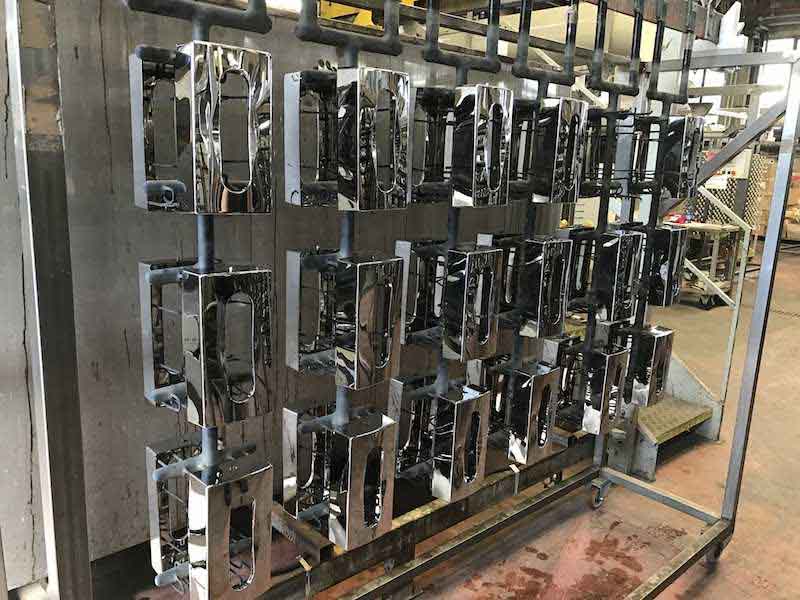Trivalent chromium or tri-chrome tends only to cause issues when it reaches approximately 0.5-1 opg or about 1-3 percent of the average total chromic acid figure, often ~33 opg.
Hard chrome baths will inevitably build up in tri-chrome because it is an unavoidable byproduct of the electrochemical reaction at the cathode, where the chromium deposit is formed by the reduction of chromium ions. If the lead anodes are working correctly, much of the Cr3 that does develop is re-oxidized to the hexavalent chromium (hex-chrome, Cr6) state, and the bath maintains a level of operational stability.
 Adam BlakeleyThe anodes can begin to polarize or shut down their ability to conduct current to the point that they distribute a weak and insufficient amount of current due to the formation of a yellow lead chromate film or a brown lead dioxide film that is too thick and heavy. The anodes are then stripped and re-energized, enabling them to continue to vitiate and moderate the growth of tri-chrome through re-oxidation efforts.
Adam BlakeleyThe anodes can begin to polarize or shut down their ability to conduct current to the point that they distribute a weak and insufficient amount of current due to the formation of a yellow lead chromate film or a brown lead dioxide film that is too thick and heavy. The anodes are then stripped and re-energized, enabling them to continue to vitiate and moderate the growth of tri-chrome through re-oxidation efforts.
Anodes can polarize for several reasons, including insecure connections, bad rectifiers, inadequate or excess voltage, and insufficient anode area (a 2-to-1 to 4-to-1 anode-to-cathode ratio is ideal).
Organic interaction with the hex-chrome ions in solution can cause a reduction of those ions to the tri-chrome form. These organics come from a multitude of sources, including manufacturing oils, polishing compounds, unstable maskants, and pretreatment surfactants. Plastic components that contact the solution can become degraded due to the highly oxidative and acidic nature of the chromic acid at high temperatures (140°F), causing Cr3 to form.
So how does tri-chrome impact quality? Tri-chrome excesses can cause hard chrome baths to become even more inefficient than they currently are, taking the 17% average efficiency figure (the amount of energy used in successfully producing a deposit) down to 8% - 12%, which can often result in the loss of an entire eight-hour shift of production. Covering power (the ability to plate in the low current density regions of a part) is notoriously terrible in all hex-chrome solutions, but it can be substantially worse with a surfeit of tri-chrome.
Burning and nodulation (a phenomenon in which the high current density region of a part becomes exfoliated, roughened, and darkened) are common with the introduction of too much tri-chrome. Macro-cracks are large cracks that hurt corrosion and wear resistance and can form instead of micro-cracks with too much Cr3, as can a softer deposit. And finally, to add insult to injury, the deposit itself might not even effectively adhere to the substrate if tri-chrome concentrations reach exorbitant levels.
There are three popular tests for determining if a bath is infected with excess Cr3:
- The first is the basic titrimetric method, which first finds the Cr6concentration in a solution and then, once an oxidant is added, is repeated to find the Cr3figure by subtracting the initial smaller figure from the final larger figure.
- The second is the visual method. When tri-chrome builds in a bath, it turns darker, and so by creating standards of known tri-chrome concentration using a measured amount of a reducing agent like sucrose, you can achieve a line-up of standards contaminated with precise amounts of tri-chrome to compare to the actual plating bath under inspection.
- The third is the spectrophotometric method, which is the technically precise version of the visual method that uses a calibrated machine to measure colors and wavelengths given by a sample of chrome solution.
Here are some ways to combat tri-chrome
- A bath already inundated with tri-chrome is often assisted by raising the chromic acid and sulfate figures and any other catalysts being used, like fluoride.
- Keep electrical resistances at their lowest to attenuate Cr3by checking connections, inspecting the anodes, evaluating and replacing the rectifier components, and cleaning the busbars.
- Avoiding the introduction of organics into the bath from the stages already mentioned is crucial, as is ensuring that plastic elements used in the bath have not degraded and replacing the ones that have.
- Performing a high current density dummy operation with low cathode area and high anode area will help oxidize the tri-chrome back to hex, as will the use of a porous pot, which uses this oxidation method to a more sophisticated and controlled degree. Electrodialysis is similar to porous pot technology, only it uses an ion-exchange membrane with a film resin.
- Removing a portion of the bath is always an option for those who require a reduction in Cr3levels quickly and reliably without trusting in other more intricate and often abstruse technological innovations.
Hard chrome baths will grow in trichrome to a degree, but with properly operating anodes, the increase will be minimal and manageable without incurring major issues. It is paramount, however, that operators utilize the methods they have available to them for testing to ensure their tri-chrome is not growing. If the tests prove positive for tri-chrome growth, this information should help them know where to look and how to rectify the situation without having to reactively address issues as they arise and without being stumped as to why parts are coming outburned, nodulated, macro-cracked, soft, blistered, pitted, dull, hazy, and with low plating thicknesses and/or poor coverage.
Adam Blakeley, MSF, and CEF, is Technical Manager of the Eastern Region at MacDermid Enthone Industrial Solutions. Visit www.macdermidenthone.com



































